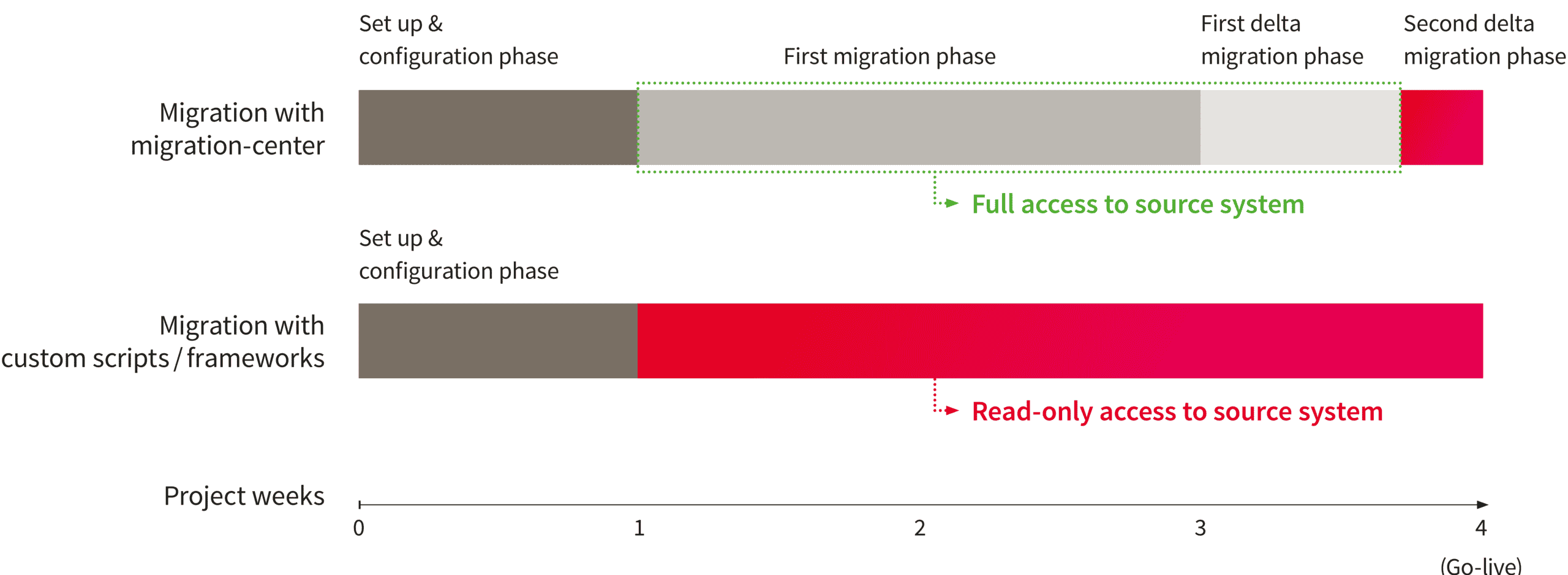MEDIA
HELP
Author
Frank D’Entrone
Head of Business Development @ fme US
November 15, 2023
There’s no one-size-fits-all solution to moving data as part of a major system consolidation project or a new re-platform deployment, but there are optimal decisions to ensure a smooth and stress-free transition. fme’s subject matter experts, harnessing tools such as our migration-center solution, will help you enable the right path based on your particular business needs.
When you’re planning a major application change involving a vast amount of data or contents, there are two main approaches you can take to manage the migration aspect – running it as a big bang or as a controlled, phased transition. And the most favorable choice will depend on your particular business circumstances.
If there are multiple system dependencies either upstream or downstream, so that working in multiple systems during a staged migration would be untenable, then a big bang approach may be the only viable option from a change management perspective to minimize business disruption.
Although it can be painful to endure the downtime required for a single all-encompassing migration from the old to the new state, there are ways to minimize the pain and risk.
If it’s a large system, proper planning including dry-running, and a targeted cutover time with a detailed step-by-step cutover plan will be important to ensure that user access isn’t disrupted during critical times, and to guard against errors or gaps in the data in the new platform. Crucially, planning must include assessments of the quality and integrity of the data and any work that will be needed to clean this up, fill data gaps, and ensure that teams can confidently rely on it once using the new system.
Our migration technology makes it possible to perform an initial large migration, while shielding the data from users via appropriate security layers so that they do not access or use the migrated data prematurely.

Our migration software migration-center allows for the actual data transfer to be split into an initial large migration (pre cutover) and a subsequent second short migration phase with one or multiple deltas until the actual cutover migration, significantly reducing user downtime compared to custom solutions.
Once the first major initial transition has taken place, there will be an incremental cutover of any new or modified records. This delta option, which can include one or multiple subsequent delta runs, helps to minimize user downtime, confining the final cutover to a designated period such as a weekend or extended public holiday. By restricting the outage window, you can enjoy the best of both worlds – the clear-cut nature of a big bang migration, but with minimal business disruption as system usage is switched.
The alternative approach is to control the migration so that it happens in stages. In this way, the changeover takes place gradually, with smaller data volumes, at a pace the business can cope with. The staged approach can help to contain any risk and bring users on a journey rather than switch everyone over en masse and hope for the best.
Examples of a controlled, staged migration include a system by system, platform by platform, or repository by repository transition, or a phased migration by segment – e.g. by line of business, or by product/portfolio/cluster. In Life Sciences, for instance, the migration might be broken down by site, e.g. when targeting Quality and Manufacturing, so that any disruption is only partial.
This gradual approach can help by building maturity across the teams, and by providing the opportunity to iron out any kinks on the road.
Approaching a system migration or re-platforming in small bites gives the different user groups a chance to familiarize themselves with new features or ways of working, and to ‘sell’ it to colleagues elsewhere once they have experienced the benefits. Leaving around three months between stages is a common approach, to keep the migration manageable and to allow each next phase to build on any lessons or improvements from earlier tranches.
We are unique not only in our ability to support delta migrations and phased approaches, but also in our support for multiple legacy systems and data sources, as well as leading modern content services target platforms, as part of a consolidation or harmonization project. We support vast scalability, too – being able to manage and migrate tens or even hundreds of millions of records, while also vetting these collaboratively with our clients to ensure we are not preparing and migrating data that is now redundant.
Importantly, we validate and verify all migration work of course, to ensure the quality and integrity of the data in the new system. This means that users can use the migrated data confidently in their everyday work and can trust any associated outcomes. This validation is fully auditable, tracking the complete chain of custody of data from its source to the target system. This level of transparency and auditability is critical in regulated industries, and – along with our migration technology solution portfolio – it sets fme apart from other ECM platform services providers.

fme and its content migration software migration-center are officially certified partners of several leading ECM providers.
We’re in lockstep with all of the major content management solution vendors, from Veeva to Hyland, OpenText, Microsoft, and Generis, and more. As these software companies add to their portfolios, so do we support their updated solutions, boosting the value of clients’ investments in their platforms via complementary migration accelerators.
Need help with your content migration strategy?
To discuss a specific data migration requirement or find out more about our extensive range of migration-center capabilities, just reach out to us and we’ll get you connected with our migration experts.

 6 major pitfalls to avoid in your content migration – Part II
6 major pitfalls to avoid in your content migration – Part II